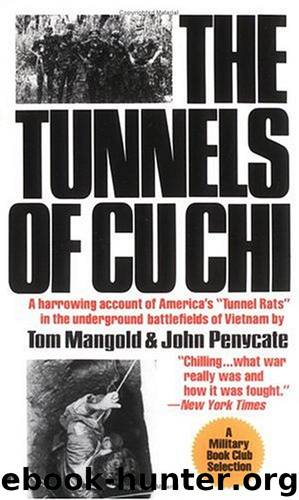The Tunnels of Cu Chi by Tom Mangold

Author:Tom Mangold [Mangold, Tom]
Language: eng
Format: epub
ISBN: 978-0-307-83336-5
Publisher: Random House Publishing Group
Published: 2013-03-26T16:00:00+00:00
Let’s grow manioc plant all over the bomb craters and make them green.
We kill the Americans with their own shells and bombs.
We kill the enemy and increase our production,
Those were our glorious victories.
Some songs were love songs. But Bay Lap, a sterner follower of the party line than Pham Sang, insisted that even love songs should carry a message. In the end, Pham Sang wrote a hybrid lyric—it was, he admitted, not his finest—the first line of which was: “I love you, I miss you and wait for you, liberation fighter, let’s fight the enemy together.” Bay Lap felt strongly that the main purpose of this song was to encourage the soldier to fight and the girl to work harder. Pham Sang, who was beginning to feel the first stirrings of artistic integrity in a socialist environment, wanted the song to be mainly romantic. He lost. Bay Lap is today the deputy director of cultural affairs in Ho Chi Minh City; Pham Sang is right out of show business.
Tensions were now beginning to develop between Pham Sang and the party. He believed his entertainers were not always getting a square deal; he did not like being told specifically what to write—there had to be some individuality in the theater; and it seems likely that he was beginning to have one or two tiny doubts about the general course of the revolution. According to him: “The Cu Chi District Committee patronized the Cu Chi cultural troupe, but troupe members did not enjoy a definite status as actors and artists do now (1983). There were times when we suffered much hardship. During the dry season, whenever it was possible, we gave performances. During the rainy season and in great fighting, we could not always perform. So we were forced to earn our living as laborers.
“My actors and actresses and singers became seasonal workers, plowing, sowing, harvesting rice in ‘safe’ areas. They were real actors and now they had to do these kinds of work. They even had to take turns as hired hands. There were no regulations as we have now. Now artists and actors can collect their monthly ration of rice. The Front only fed us if we were in a desperate situation. Some of my colleagues worked as slaves to support themselves and their comrades, like Ut Tho, who is now in charge of a cinema in District 5. He worked as a laborer season after season, just to stay alive.”
By 1968, unequivocal instructions from COSVN pointed out sharply that the tunnels were primarily for battle purposes. By implication, their use for entertainment was a very low priority. In order to retain the use of tunnels for his productions at all, Pham Sang restricted tunnel performances to those for party hierarchy, civil servants, and soldiers. The others, the bulk audience—friends, peasants, and Sunday workers—had to take their places in the revolutionary new al fresco theaters created in B-52 bomb craters. Some thirty feet deep, these craters were narrow at the bottom and very wide at the top.
Download
This site does not store any files on its server. We only index and link to content provided by other sites. Please contact the content providers to delete copyright contents if any and email us, we'll remove relevant links or contents immediately.
| Afghan & Iraq Wars | American Civil War |
| American Revolution | Vietnam War |
| World War I | World War II |
Waking Up in Heaven: A True Story of Brokenness, Heaven, and Life Again by McVea Crystal & Tresniowski Alex(37715)
Empire of the Sikhs by Patwant Singh(23021)
We're Going to Need More Wine by Gabrielle Union(19003)
Hans Sturm: A Soldier's Odyssey on the Eastern Front by Gordon Williamson(18529)
Leonardo da Vinci by Walter Isaacson(13235)
The Radium Girls by Kate Moore(11970)
Tools of Titans by Timothy Ferriss(8304)
Educated by Tara Westover(8001)
How to Be a Bawse: A Guide to Conquering Life by Lilly Singh(7436)
Permanent Record by Edward Snowden(5795)
The Last Black Unicorn by Tiffany Haddish(5601)
The Rise and Fall of Senator Joe McCarthy by James Cross Giblin(5246)
Promise Me, Dad by Joe Biden(5112)
The Wind in My Hair by Masih Alinejad(5056)
A Higher Loyalty: Truth, Lies, and Leadership by James Comey(4905)
The Crown by Robert Lacey(4761)
The Iron Duke by The Iron Duke(4319)
Joan of Arc by Mary Gordon(4053)
Stalin by Stephen Kotkin(3918)
